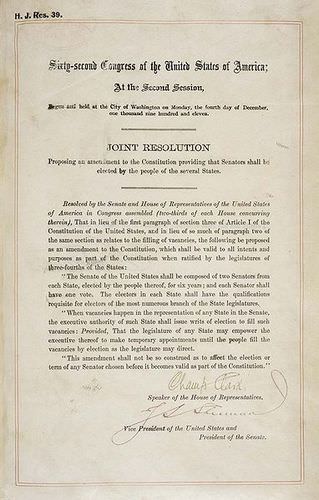4.7: The Seventeenth Amendment
- Page ID
- 5851

The new plan of bicameral legislation with the House representing the people through direct election and the Senate representing the states through appointment by state legislatures would remain until the 17th Amendment to the Constitution was passed in 1913. This amendment changed the selection of Senators from one based on appointment or selection by state legislatures to one in which Senators were directly elected by the people. This change occurred because of a series of scandalous elections in the late 1800s and early 1900s that made citizens resent Senators who they perceived as being selected because they were friends or business associates of the legislators rather than because they were qualified.
Video: The Seventeenth Amendment for Dummies
Amendment XVII
The Senate of the United States shall be composed of two senators from each state, elected by the people thereof, for six years; and each senator shall have one vote. The electors in each state shall have the qualifications requisite for electors of the most numerous branch of the state legislatures.
When vacancies happen in the representation of any state in the Senate, the executive authority of such state shall issue writs of election to fill such vacancies: Provided that the legislature of any state may empower the executive thereof to make temporary appointments until the people fill the vacancies by election as the legislature may direct.
This amendment shall not be so construed as to affect the election or term of any senator chosen before it becomes valid as part of the Constitution. [1]
Filling Vacancies
The 17th Amendment states that a state legislature may allow the governor to make temporary appointments, which last until a special election is held to fill the vacancy. As of 2009, all but four states—Massachusetts, Oregon, Wisconsin and Oklahoma — permit such appointments. [49] The Constitution does not detail the selection of the temporary appointee. Then, the 17th Amendment requires a governor to call a special election to fill the vacancy.
In 1911, the House of Representatives passed House Joint Resolution 39 proposing a constitutional amendment for direct election of senators. The original resolution passed by the House contained the following clause: [33]
The times, places, and manner of holding elections for Senators shall be as prescribed in each State by the legislature thereof.
This so-called "race rider" clause would have strengthened the powers of states over senatorial elections and weakened those of Congress by overriding Congress's power to override state laws affecting the manner of senatorial elections.[34]
Since the early 1900s, most blacks in the South and many poor whites had been disenfranchised, or deprived of a right or privilege, by state legislatures passing constitutions with provisions that were discriminating against them.
Therefore, there was a large segment of the population that was not represented. Most of the South had one-party states. When the resolution came before the Senate, a substitute resolution, one without the rider, was proposed by Joseph L. Bristow of Kansas. It was adopted by a vote of 64 to 24, with 4 not voting. [35] The House accepted the change almost a year later. On May 13, 1912, the conference report that would become the Seventeenth Amendment was approved by the Senate 42 to 36 on April 12, 1912, and by the House 238 to 39, with 110 not voting.
The Senate Today
What would the Senate look like today if the 17th Amendment had not been ratified?
Visit this link: Constitution Daily: What would the Senate look like today without the 17th Amendment?

Study/Discussion Questions
1. What did the 17th Amendment state?
2. Why was it important?
3. Do you think that disenfranchisement was successfully fixed with the passage of the 17th amendment? Why or why not?
Sources:
[1]. "The Constitution of the United States Amendments 11–27". National Archives and Records Administration. Retrieved 16 June 2018. 49] "17th Amendment to the U.S. Constitution: Direct Election of U.S. Senators".
August 15, 2016.
[33] "17th Amendment: Direct Election of U.S. Senators".August 15, 2016.
[34] Zachary Clopton & Steven E. Art, "The Meaning of the Seventeenth Amendment and a Century of State Defiance", 107 Northwestern University Law Review 1181 (2013), pp. 1191-1192 [35]"17th Amendment to the U.S. Constitution: Direct Election of U.S. Senators". August 15, 2016.

